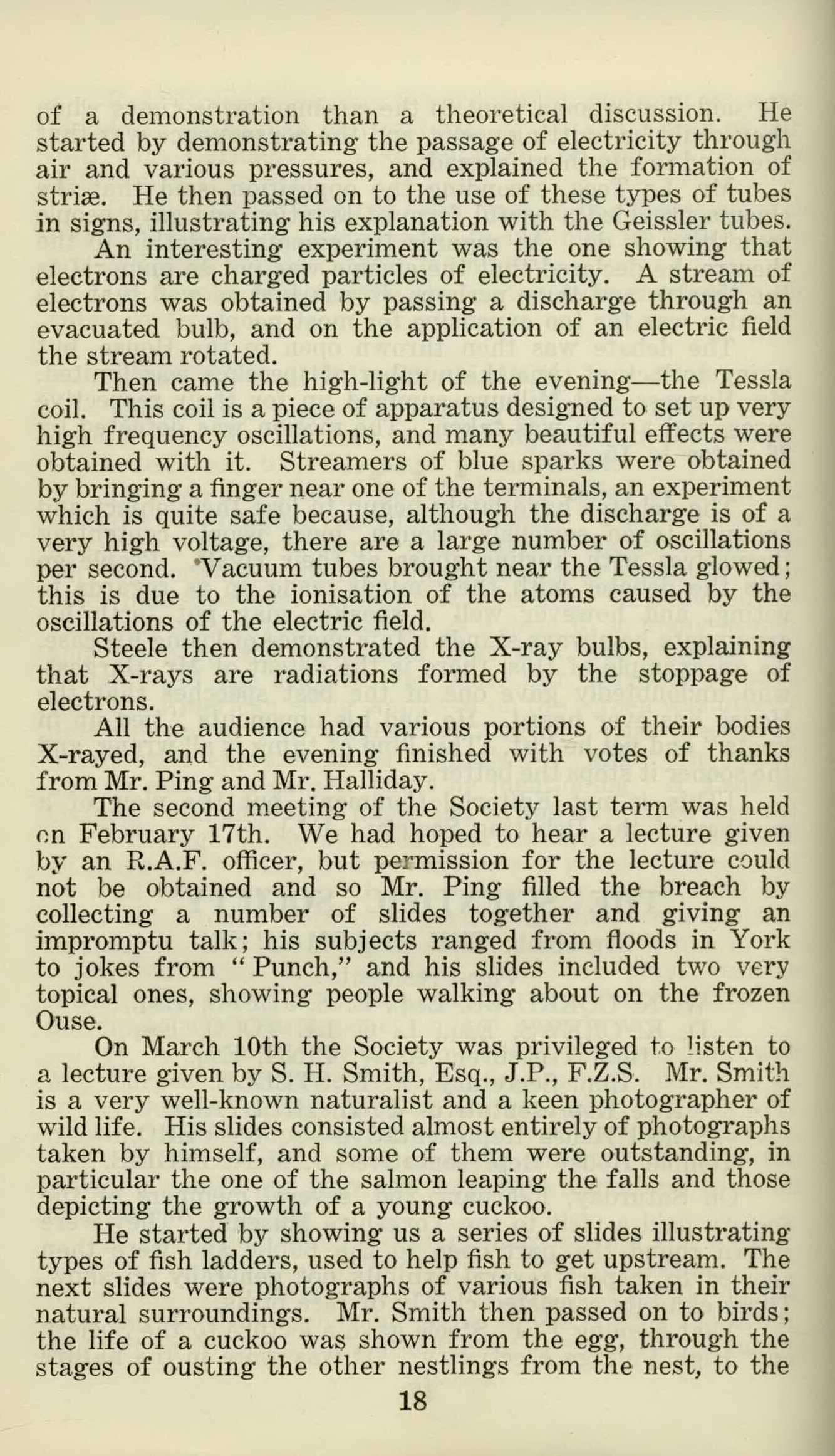
4 minute read
The Scientific Society
from April 1940
by StPetersYork
He said that women went to the cinema during times when they could be knitting socks, and the consequence was that they had to buy them instead.
Mr. Le Tocq, seconding the opposition, said that the cinema provided a useful form of taxation and gave people something to do. As regards the cinema's relation to the theatre, he declared that the cinema was not so immoral as the theatre and thus, perhaps, it was just as well that the theatre was far too expensive for most people.
The debate was then thrown open to the House, but owing to lack of time the number of speeches was limited. Mr. Burgess and Milburn summed up for their respective cases, and a vote was taken. The motion was defeated by 26 votes to 15. * *
The debates have lately begun to lose their object and are not taken seriously enough, most people contenting themselves with hurling abuse at their rivals. People go into the debates with their minds made up as regards to voting, and however well a speaker may put forth his arguments he always stands a fair chance of losing his case. As an example of this, there is the defeat of Mr. Burgess, who undoubtedly gave one of the best speeches that the House has ever heard. He had his opponents " tied up in knots " and yet he lost. This kind of thing is all wrong, and the sooner it stops the better. [This is not Editorial Comment, but the view of a member of the Debating Society.—Ed.]
President: THE HEADMASTER. Vice-Presidents : W. N. CORKHILL, Esq., E. S. JEFFS, Esq., D. K. CREWS, Esq., L. C. LE TOCQ, Esq. Hon. Treasurer : A. W. PING, Esq. Hon. Secretary : F. F. STEELE. Rise Representative—F. H. HILLYARD. School House Representative—G. W. VERO.
Temple House Representative—J. McN. INGLIS.
On Saturday, February 2nd, several members of the Society paid a visit to the Yorkshire Museum. They were shown round the part open to the public and were then allowed to inspect several exhibits not generally on show. These exhibits consisted chiefly of rare birds.
That evening F. F. Steele gave a lecture to the Society on " High Voltage Electricity." It was more in the nature 17
of a demonstration than a theoretical discussion. He started by demonstrating the passage of electricity through air and various pressures, and explained the formation of striae. He then passed on to the use of these types of tubes in signs, illustrating his explanation with the Geissler tubes.
An interesting experiment was the one showing that electrons are charged particles of electricity. A stream of electrons was obtained by passing a discharge through an evacuated bulb, and on the application of an electric field the stream rotated.
Then came the high-light of the evening—the Tessla coil. This coil is a piece of apparatus designed to set up very high frequency oscillations, and many beautiful effects were obtained with it. Streamers of blue sparks were obtained by bringing a finger near one of the terminals, an experiment which is quite safe because, although the discharge is of a very high voltage, there are a large number of oscillations per second. *Vacuum tubes brought near the Tessla glowed ; this is due to the ionisation of the atoms caused by the oscillations of the electric field.
Steele then demonstrated the X-ray bulbs, explaining that X-rays are radiations formed by the stoppage of electrons.
All the audience had various portions of their bodies X-rayed, and the evening finished with votes of thanks from Mr. Ping and Mr. Halliday.
The second meeting of the Society last term was held on February 17th. We had hoped to hear a lecture given by an R.A.F. officer, but permission for the lecture could not be obtained and so Mr. Ping filled the breach by collecting a number of slides together and giving an impromptu talk ; his subjects ranged from floods in York to jokes from " Punch," and his slides included two very topical ones, showing people walking about on the frozen Ouse.
On March 10th the Society was privileged to listen to a lecture given by S. H. Smith, Esq., J.P., F.Z.S. Mr. Smith is a very well-known naturalist and a keen photographer of wild life. His slides consisted almost entirely of photographs taken by himself, and some of them were outstanding, in particular the one of the salmon leaping the falls and those depicting the growth of a young cuckoo.
He started by showing us a series of slides illustrating types of fish ladders, used to help fish to get upstream. The next slides were photographs of various fish taken in their natural surroundings. Mr. Smith then passed on to birds ; the life of a cuckoo was shown from the egg, through the stages of ousting the other nestlings from the nest, to the
18











